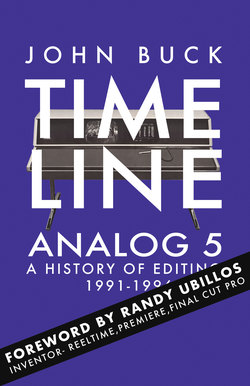Читать книгу Timeline Analog 5 - John Buck - Страница 22
На сайте Литреса книга снята с продажи.
CMX-6000
ОглавлениеThe company that should have dominated digital editing didn’t. The CMX-6000 editing system had been used to edit Bertolucci's The Sheltering Sky as well as Universal Television's television series Law and Order. Producer Dick Wolf told the trade press that he preferred the 6000 to film editing systems for his post-production requirements. Bruce Sandzimier from Universal told the press:
It works well for them. But they are also conscious of trying to reduce costs.
However, the endorsements weren’t enough. Then CMX’s fortunes changed again.
The UK based Carlton Communications dropped plans to buy CMX’s parent company Chyron. Chyron had been in and out of bankruptcy through 1991.
Instead 'The Hollywood Reporter' announced that Pesa, a member of the Amper Communications group in Spain, bought the Chyron business and brands like Aurora and CMX.
Once the sale was settled management decided to create a lower-cost version of the CMX-6000 editing system to be called Cinema.
It began the process of gathering industry opinion on what was needed in Cinema.
Gene Simon recalls:
At the time development started, the CMX 6000 was struggling to compete as a nonlinear system and the linear online product, the CMX 3600 was running out of competitive steam because new features were not easily added.
Additionally, the separate Z80 I2 architecture was another added cost compared to our competition. Cinema was primarily different from the 6000 because the laser disks were replaced with JPEG compression and 8” hard drives. The drive modules included Truevision compression cards and Matrox decoder cards.
Editor Michael Rubin became the senior designer while Rick Foster was the key software engineer. The CMX team also began development of the Omni 500 and Aegis.
Gene Simon became project manager with Richard Bardini as the software lead engineer and Bob Glenn as the hardware lead engineer.
Because developing an all-new hardware and software architecture was a huge task, CMX split the development into two projects. After years of products built on assembly code and a proprietary real-time operating system, Simon’s team wrote the new code in C, and moved to pSOS on a UNIX platform. Simon concludes:
For the Omni user interface, Rick ported X-Windows to run under pSOS instead of UNIX, which was quite an accomplishment. It was a big event when we got that big ‘X’ to pop up on the screen.
Cinema was its nonlinear offering, the Omni 500 was a part offline/online editing system; and the Aegis was an online editing system.
